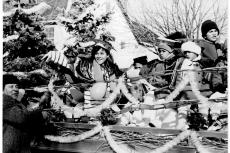Everybody knows that sticks and stones may break bones, but apparently not everyone knows they don’t belong in the public right of way.
Nothing does, except maybe a mailbox, a utility pole, or a fire hydrant.
That was the message in a joint presentation from Councilman David Lys and Kevin Cobb, a highway project inspector from the Highway Department, at the Aug. 5 East Hampton Town Board meeting.
The public right of way is a variable strip of land, usually 10 to 15 feet, measured from the edge of the road and owned by the town or another municipality. Perhaps if the term weren’t so forgettable and changed to “dead zone,” or something equally threatening, residents would stop placing objects or plantings in them.
While violation stories could be humorous, these generally nondescript strips often serve important safety functions. They allow for maintenance, drainage, and utility access, too.
Mr. Cobb told of a recent encounter with a resident who planted a green giant arborvitae hedge directly in the road verge, preventing the town from maintaining its drainage system.
“The guy said, ‘I’ll sue the town,’ “ Mr. Cobb recalled, and remembered that the resident pointed to a row of 30-year-old cedar trees in his neighbor’s right of way as justification for keeping his hedge.
The town dropped the matter.
In another instance, a man asked the Highway Department to move a “no parking” sign. Why? The resident explained that while it was a line-of-sight issue, he also wanted to park there.
“You can’t make this stuff up,” said Mr. Cobb.
The right of way is crucial for allowing drivers to pull aside for emergency vehicles, and it provides those same vehicles a place to park when accessing a property. They preserve a line of sight, especially on corner lots, and can serve
as a safe place for pedestrians or future bike lanes.
While pollinator pathways have received lots of press in recent years, the road verge also acts as a chain of potential connected habitat and can add to community character.
Homeowners may receive a permit to extend a driveway through a right of way, but a utility may still rip it up if they need to access underground equipment.
Boulders, berms, sticks and stones, these are all not allowed, the men explained. Border plantings must be designed with future growth in mind.
Turns out, right of ways infractions are a pet peeve for many.
David Buda, a resident of Springs, complained that “existing town ordinances are paltry” and that enforcement within the town rights of way has been sporadic and ineffective.
Martin Drew, whose family owns property near Rita Cantina, a restaurant operating in a residential neighborhood, claimed the establishment has long abused nearby road verges, using them as parking areas, or a place to store their trailers.
“It seems that you guys want to tell us that public safety is number one, but I’m having a hard time digesting that statement because of the simple fact that the right of way has been encumbered with an illegal parking lot,” he said.
The tone of the presentation was light and focused on education. There wasn’t discussion of new legislation or a hard-hitting enforcement push; however, Mr. Cobb said they had begun to place fliers at properties where they found violations.
“If we don’t get compliance, we will take the appropriate means and reserve our rights out there,” he said. “I put a lot of fliers on houses that say, ‘If you do not cut back, the Highway Department will do it.’ “
“Some people say, ‘Oh, good. Let them do it.’ “
He warned, however, that aesthetics weren’t his thing. “I don’t do a nice job.”



